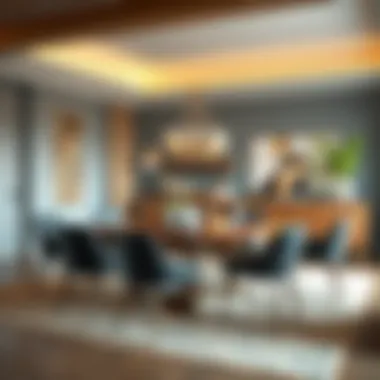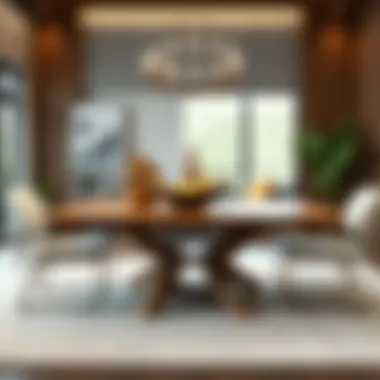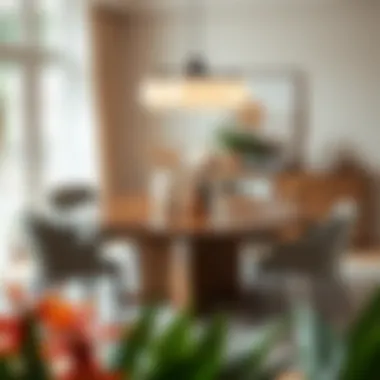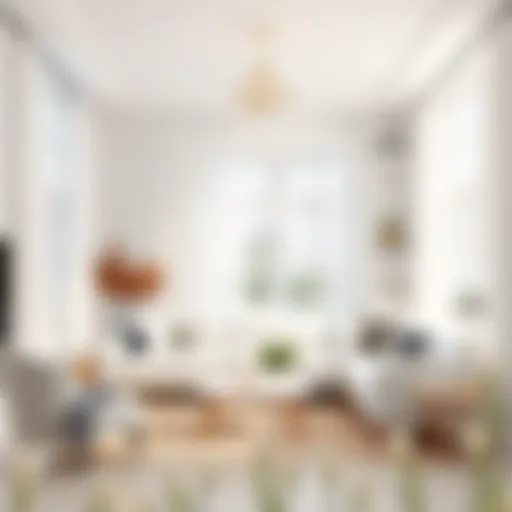Explore the Functionality of Dining Room Tables with Leaf


Intro
When it comes to enhancing the heart of your home, the dining room table often takes center stage. It's not merely a piece of furniture; it serves as a gathering place for meals, celebrations, and heartfelt conversations. Tables with leaf extensions, in particular, combine versatility with style. They can transform from a cozy setting for two to a grand area that accommodates family gatherings. In this comprehensive overview, we will navigate through various styles, practical advantages, and key considerations for selecting the perfect dining room table with a leaf mechanism. Along the way, we’ll explore maintenance tips and current trends that can elevate your dining experience.
Furniture Styles and Trends
Modern vs. Traditional: Understanding the Aesthetics
A dining room table reflects the personality of the household, and it can be a real game changer when it comes to design aesthetics. On one hand, modern tables embrace clean lines and minimalism. These tables often utilize materials like glass or metal, presenting a sleek and sophisticated appearance. They cater to a younger audience or those seeking a clean, contemporary vibe in their space.
Conversely, traditional tables often embrace warmth through rich woods like oak or cherry, featuring intricate carvings and sometimes ornate detailing. They echo a sense of history and cherished memories, perfectly suited for those who value timelessness.
When choosing between modern and traditional styles, it can help to think about your existing decor. After all, the right table should harmonize with your other furnishings, creating a cohesive look.
Color and Material Trends: What's In and What's Out
When it comes to color and materials, current trends lean towards natural finishes that highlight the grain of the wood, with deep tones also making a noteworthy resurgence. Think walnut or mahogany for a luxurious feel, or lighter options like maple for a more airy, casual ambiance.
Materials have taken a turn as well. While wood naturally remains a staple, there's an increasing interest in sustainable materials. Bamboo tables are gaining traction for their durability and eco-friendliness.
Here's a quick rundown of what's trending:
- Warm Wood Tones: Rich stains like walnut and cherry are back.
- Sustainable Choices: Eco-conscious materials, such as bamboo and reclaimed wood.
- Mixed Materials: Combining wood with metals or stone is popular.
"Choosing the right dining table is not just a decision about style, but about creating a space that feels welcoming and reflects who you are."
Furniture Care and Maintenance
Tips for Prolonging the Life of Your Furniture
Investing in a dining room table, especially one with a leaf mechanism, deserves thoughtful care. Simple maintenance can ensure it serves you well over the years. Here are some tips:
- Clean Regularly: Use a damp cloth and a mild soap solution to wipe down surfaces, avoiding harsh chemicals that can dull the finish.
- Protect Surfaces: Use placemats or coasters to prevent scratches and heat damage.
- Control Humidity: Maintain a consistent indoor climate. Excess humidity can warp tables, while dry air can cause splits.
DIY Repair Hacks for Common Furniture Issues
Furniture can face its fair share of wear and tear. Fortunately, minor repairs can often be handled at home:
- Scratch Repair: Use a walnut or furniture marker to fill in scratches – it’s quick and effective.
- Wobbly Legs: Check for loose screws in table legs and tighten them if needed. If the issue persists, adding a furniture leg brace can provide extra support.
- Water Rings: Place a mix of olive oil and vinegar on a cloth and rub it over the affected area. It should lift the ring without causing further damage.
By following these tips, your dining table will not just last longer but will also continue to look its best, enhancing your dining environment with charm and functionality.
For more on furniture care, check out The Spruce for detailed articles on keeping your furniture in tip-top shape.
Preface to Dining Room Tables with Leaf
Dining room tables with leaf extensions have become quite the conversation starters in homes, blending functionality with style. These versatile pieces are not merely furniture; they serve as the heart of family gatherings, holiday feasts, and celebrations. Understanding the significance of a leaf-extension table is crucial for anyone looking to enhance their dining experience.
Defining Leaf Extensions
The term "leaf" refers to a portion of the table that can be added or removed, creating a larger surface area. Imagine a compact dining table, comfortably seating four for an average evening dinner; with the addition of a leaf, it could graciously accommodate eight or more during a festive gathering. This flexibility often stems from various mechanisms that allow the leaves to be seamlessly integrated into the table's design, thus providing both convenience and versatility.
Leaf extensions can come in different forms, like drop leaves, which can be folded down when not in use, or butterfly leaves, which store inside the table. No matter the design, the core idea remains the same: adaptability. This adaptability is not only practical but also speaks volumes about the craftsmanship behind these tables.
Purpose and Utility
At its core, a dining room table with a leaf serves multiple purposes beyond merely holding food. It transforms spaces and accommodates varying needs—be it a simple family dinner or a grand holiday feast. For homeowners, this translates not just into extra seating but also a dynamic dining environment where family and friends can gather comfortably.
When it comes to utility, these tables stand out for several reasons:
- Space-saving Solution: In smaller living areas, having a table that expands can make a world of difference.
- Hosted Events: Whether you're planning a dinner party or a game night, the ability to adjust table size is invaluable.
- Design Versatility: With a multitude of styles and finishes available, these tables fit seamlessly into various décor aesthetics.


Types of Leaf Extensions
When it comes to dining room tables with leaf extensions, the variety of mechanisms available can greatly affect not only the functionality but also the aesthetic appeal of your dining space. Understanding the different types of leaf extensions is essential for homeowners, designers, and anyone looking to enhance their dining experience. Each type offers unique benefits and considerations that can influence your decision on which table to choose.
Drop Leaf Mechanism
The drop leaf design is often considered one of the most versatile options available. In this setup, one or both sides of the table can be dropped down when not in use, allowing for increased space efficiency.
This mechanism shines when you're short on room, transforming a spacious table into a compact piece that fits seamlessly into smaller dining areas or kitchens. The simplicity of this design means it can easily blend with various decorating styles, from farmhouse rustic to modern minimalism.
Key Benefits:
- Space-saving capabilities, ideal for smaller homes.
- Quick and easy to set up for dining.
- Customizable by adding decorations or table settings only when needed.
However, do consider the sturdiness of the table when the leaves are raised. Some might find that using this mechanism regularly calls for an extra bit of care, as the hinges may require maintenance over time.
Butterfly Leaf Design
The butterfly leaf stands out for its innovative folding design. With this style, a leaf or leaves fold out from the center of the table. Generally, it involves a seamless integration that hides the leaf when it’s not in use, giving the table a sleek, continuous surface.
This offers a clean aesthetic; you don’t have to fuss with removing pieces or adjusting the height, just lift the center and out it spreads. It's also user-friendly; no complicated adjustments needed, making it as straightforward as pie, even for those not particularly handy with furniture.
Considerations:
- Look for robust hinges to avoid wear and tear.
- Ideal for those who often host family gatherings or dinner parties, adding a few extra seats without hassle.
Self-Storing Leaves
Self-storing leaves are a dream for people who are concerned about storage and convenience. These tables come equipped with built-in storage for the leaves themselves. When not in use, the leaves can be tucked away in a dedicated section of the table, making setup and teardown as easy as pie.
One notable benefit of this design is that it keeps everything neat and tidy, ensuring you won’t misplace the leaves—or trip over them when you’re trying to tidy up.
Benefits of Self-Storing Leaves:
- Eliminates the hassle of finding spare parts.
- Streamlined look when not extended.
- Perfect for people who enjoy seamless transitioning from daily use to hosting larger gatherings.
In summary, the choice between drop leaf, butterfly leaf, and self-storing leaves significantly impacts both the functionality and look of your dining environment. Opting for the right mechanism means considering not just your space but also your lifestyle and how you engage with your dining area.
"Choosing the right type of leaf extension can make a world of difference in how your dining room serves you."
For further details, check resources on Wikipedia and Britannica.
By weighing the features and practicalities of each design, homeowners can select the ideal dining room table that not only meets their needs but also enhances their dining experience.
Materials and Aesthetics
When selecting a dining room table with a leaf extension, the choice of materials significantly influences not only the table's function but also its aesthetic appeal. The materials used in furniture can affect durability, maintenance, and the overall vibe of your dining space. Homeowners, designers, and enthusiasts should pay close attention to these factors as they can dictate the longevity and look of the table.
Common Wood Types
Wood has been the go-to material for dining tables for centuries. Different types of wood offer unique characteristics and styles:
- Oak: Renowned for its durability and attractive grain, oak reflects a classic charm. It holds up well to daily use, making it an excellent choice for families.
- Walnut: Darker and richer, walnut provides a sense of luxury. Its complex grain patterns make each table unique, appealing to those looking for something special.
- Maple: A lighter wood that is often used for modern designs. Maple is hard and resistant to scratches, appealing for those who prioritize function without compromising style.
- Pine: While softer and less expensive, pine has a rustic look and can be great for casual settings. Its knots and imperfections can lend character, appealing to DIY enthusiasts looking to refine their pieces.
Homeowners should consider the finishes on these woods as well. A glossy finish adds elegance but requires more maintenance, while a distressed look can hide scratches and offer a cozy aesthetic.
Metal and Glass Options
In recent years, the use of metal and glass in dining tables has gained traction. These materials add a contemporary flair and can complement a variety of interior styles.
- Metal: Steel and aluminum bases often provide a sleek and modern contrast to wooden tops. Metal is generally more durable and easier to clean, which can be appealing for families with young children or pets.
- Glass: Glass tops can create the illusion of more space in a smaller dining area. They allow light to pass through, enhancing the ambiance of the room. However, they require regular cleaning to avoid smudges and fingerprints.
Incorporating metal and glass into dining tables can foster an industrial or minimalist aesthetic, which is increasingly popular in modern homes.


Combining Materials
A mixed-material table can effectively blend aesthetics with functionality. Many designers are opting for combinations that bring out the best qualities of each material:
- Wood and Metal: A wooden tabletop with a metal base is not just visually striking; it also balances warmth with a sense of solidity.
- Glass and Wood: A glass top atop a wooden base can create an elegant look, utilizing the transparency of glass to showcase the warmth of wood underneath.
- Resin Inlays: Some tables incorporate resin into the wood, allowing for vibrant colors and patterns. This unique approach adds a personal touch, making the table a focal point within the room.
When choosing a mixed-material table, it’s vital to ensure that these elements complement each other without clashing. The aim is to create a harmonious dining environment that reflects individual aesthetics while remaining functional for gatherings.
A dining room table is not just a piece of furniture; it is the heart of the home where memories are made and shared.
Functional Advantages of Leaf Tables
Dining room tables with leaves offer unique functional advantages that cater to various lifestyle needs. These tables are not just pieces of furniture; they are versatile solutions designed to enhance both functionality and aesthetic appeal in dining areas. The ability to expand or contract a table depending on the number of diners is a significant advantage that leads to various benefits, from space optimization to enhancing social interactions. Let’s delve into the specifics of how these tables can transform your dining experience.
Space Efficiency
In today’s homes, where space can be limited, dining room tables with leaf extensions stand out due to their remarkable space efficiency. When not in use, these tables can remain compact, making them ideal for small apartments or homes where every square foot matters. The leaf mechanism allows for an easy transition from a cozy, intimate setting to a spacious one when guests arrive.
- Compact Design: When the leaf is folded away, the table takes up less space, freeing up room for movement and other furniture.
- Utilization in Different Settings: These tables can seamlessly fit into various spaces, from formal dining rooms to casual breakfast nooks.
- Simplifies Cleaning: A smaller table means fewer surfaces to clean regularly, which is a practical consideration for busy households.
Think of it this way: it’s akin to a Swiss army knife for your dining area. It saves space yet adapts to your needs, similar to how one might use different tools for specific tasks.
Flexibility for Gatherings
Hosting a dinner party or a family feast can be daunting, especially when it comes to accommodating guests. Leaf tables shine in flexibility for gatherings by allowing users to adjust the table size based on attendance. When uninvited guests might drop by, the expandable feature becomes a lifesaver.
- Instant Expansion: When the leaf is added, it turns a four-seat table into one that accommodates eight or more, depending on the design. This adaptability supports spontaneous gatherings—right when you need it.
- Fostering Connection: Larger tables create a communal atmosphere. Friends and family can engage in conversation and share experiences across a wider table space, enhancing the overall dining experience.
- Variety of Styles: Whether it’s a formal gathering or a laid-back barbecue, different designs can suit various occasions, making these tables suitable for all types of events.
This kind of flexibility extends the utility of your dining space beyond just meals and into memories, making each gathering meaningful and memorable.
Enhancing Dining Experiences
The dining table is often the heart of the home, where families share meals and stories, and leaf tables contribute remarkably to enhancing dining experiences. By providing a larger area when needed, they not only serve functional purposes but also create an inviting atmosphere for meals.
- Encouraging Social Interaction: A larger table can help in fostering bonds. As diners gather, they share not just food but also laughter, stories, and connections, creating lasting memories.
- Stylish Statement Pieces: Beyond their practical uses, tables with leaf extensions come in various styles, wood finishes, and designs that can elevate the decor of your dining space. This eye-catching aesthetic can make meal times more enjoyable.
- Adaptable Decor: With seasonal changes or festive occasions, you can stylishly arrange table settings tailored to your theme, offering a fresh perspective every time.
"A dining table signifies a space where culinary delights meet heartfelt exchanges, bridging connections and nurturing relationships in every meal."
Considerations for Selection
When selecting a dining room table with a leaf extension, several factors come into play. This selection process is more than a simple choice; it's about merging practicality with aesthetic appeal to create a functional space where family and friends gather. Knowing what to consider can lead to a more satisfying investment and a table that suits your unique lifestyle demands.
Size and Dimensions
A crucial aspect of your decision-making revolves around the size and dimensions of the table. The size must accommodate both your dining area and the number of guests you intend to host.
- Measure your space: Before you even think about a table, grab a tape measure and check your dining area’s dimensions. You want to ensure there’s ample space for movement around the table. A good rule of thumb is to allow at least 36 inches of space between the table and walls or furniture for comfortable seating and access.
- Consider extendability: Think about how often you will use the leaf extension feature. If you frequently entertain large groups, a longer table that can comfortably seat anywhere from six to twelve people is ideal. However, if you plan on using it only occasionally, a smaller table that expands when needed can save space without sacrificing flexibility.
Design Compatibility
Matching the table's design with your existing decor is another significant consideration. The style of the table should not only complement your current furniture but also reflect your personal taste.
- Evaluate your decor: Look around your dining area. Do you lean toward a rustic farmhouse vibe, or does modern minimalism speak to you? Once you identify your decor theme, it’s easier to select a table that fits. A table with a reclaimed wood finish might suit a cozy farmhouse, while a sleek glass-top table can elevate a modern setting.
- Design elements: Pay attention to other properties, such as the table leg style and finish. For example, intricate legs may add character but could clash with contemporary furnishings that favor clean lines. Your table should harmonize with both your aesthetic and functional needs.
Budget Considerations
Last but not least, your budget will play a pivotal role in your selection process. Dining tables with leaf extensions vary widely in price due to materials, craftsmanship, and brand reputation.
- Set a realistic budget: Assess how much you can allocate without breaking the bank. While it may be tempting to opt for cheaper options, investing in quality can pay off in longevity and wear.
- Balance quality and cost: Keep an eye out for tables that provide great value without sacrificing durability. Look for solid wood tables versus veneer, as they tend to withstand the rigors of daily use better and last longer.
- Sales and promotions: Don’t forget the practicality of shopping during sales or taking advantage of seasonal promotions. Retailers often offer discounts during holiday seasons, which can significantly reduce the expenditure on a quality dining table.
In summary, being thoughtful about size and dimensions, ensuring design compatibility, and sticking to a well-defined budget can greatly enhance your experience in choosing the right dining room table with a leaf. This will create not just a dining area but a space rich with memories and shared experiences.


Maintaining Your Dining Room Table with Leaf
Keeping a dining room table with a leaf extension in good shape is more than just about aesthetics; it’s about cultivating an environment where meaningful moments happen. A well-maintained table isn’t just visually appealing — it also extends the longevity of your investment. By understanding how to properly care for these tables, homeowners and designers can ensure that these pieces remain functional and elegant for years to come. Here are some key considerations.
Cleaning and Care Tips
When it comes to maintaining a dining room table, it’s essential to implement a regular cleaning routine. Here are some straightforward tips to keep your table looking fresh:
- Use Soft Cloths: Always opt for soft, lint-free cloths when cleaning. Rough materials can scratch the surface, detracting from its beauty.
- Mild Cleaners: A simple solution of warm water and mild dish soap can work wonders. Avoid using harsh chemical cleaners that can deteriorate the finish over time.
- Immediate Spill Response: If any liquid spills occur, act fast. Wipe it up immediately to prevent stains or warps in the wood or other materials. For tougher spots, dampen a cloth with the mild soapy solution gently.
- Dusting: A dry microfiber cloth works well for regular dusting. This helps prevent any buildup that can become hard to remove later on.
These steps not only ensure the table stays in good shape but also make it a welcoming place for family and friends alike.
Protective Measures
Keeping your dining room table with leaf extension safe requires some foresight. Here are effective protective measures to consider:
- Coasters and Placemats: Use coasters for drinks and placemats for hot dishes. Heat, moisture, and scratches can warp the surface if not handled with care.
- Furniture Polish: Periodically applying a high-quality furniture polish can create a barrier against dust and moisture. This helps maintain the luster and reduces the risk of wear. However, it’s important not to overdo it as excessive polish can become sticky.
- Leaf Storage: When the leaf isn't in use, store it carefully. It’s often best kept in a clean, dry place within the table if the design allows. If not, ensure it is wrapped safely to prevent scratches or damage.
- Temperature Control: Fluctuations in temperature can cause wood to expand and contract. Placing the table away from direct sunlight or heating ducts minimizes this risk.
Taking the time to implement these measures enhances both the aesthetics and longevity of the dining table, making it a staple within the home.
Regular maintenance is not just about preserving furniture; it’s about preserving memories that happen around that table.
For more information on best practices for maintaining wooden furniture, check out resources like Wikipedia and The Spruce.
Current Trends in Dining Room Tables
In the ever-evolving world of interior design, dining room tables, particularly those with leaf extensions, have adopted various trends that resonate with contemporary living. As more homeowners recognize the need for versatility and sustainability, the latest styles are not just about function; they’re also about aesthetics and responsible choices.
Sustainable Furniture Options
The growing movement toward sustainable living has seeped into furniture design, and dining room tables are no exception. Environmentally friendly materials and processes are increasingly favored in the production of leaf tables. For example, reclaimed wood is making waves in dining room furniture. Instead of cutting down new trees, manufacturers are taking old wood from deconstructed buildings, giving it new life. This not only reduces waste but also adds character to each table, with unique marks and finishes that tell a story.
Another notable trend is the use of non-toxic finishes, ensuring that the products are safer for both the environment and the user. Manufacturers are now opting for water-based finishes instead of traditional solvent-based options, which can be harmful to both health and nature. Plus, consumers are showing heightened interest in brands that prioritize ethical sourcing and fair labor practices. Choosing a table built from sustainably-harvested materials contributes to a healthier planet while supporting responsible production methods.
"Sustainability goes beyond just products; it embodies a philosophy of responsibility and respect toward the earth."
Smart Functionality Features
Smart functionality is another hot trend in the realm of dining room tables. The modern homeowner often looks for furniture that seamlessly fits into a tech-savvy lifestyle. Incorporating technology into dining room tables enhances preparation for family gatherings or entertaining guests.
Some innovative features include tables equipped with built-in charging stations, allowing guests to keep their devices powered up during meals. This is particularly useful in gatherings where people tend to use their phones for social media or to capture memories. Additionally, tables with integrated storage for cutlery or placemats streamline the dining experience by keeping necessities close at hand.
Moreover, foldable designs are gaining traction. These tables can adapt to various room sizes and occasions, ensuring that your dining experience feels personalized whether hosting a dinner party or enjoying a quiet meal with the family. The ability to easily extend or retract the table saves space and enhances usability, aligning perfectly with urban living where every inch counts. You can find more insightful information about furniture trends at Wikipedia.
Keeping an eye on these trends ensures that your dining space remains not only functional but also visually appealing and in tune with the growing demands for sustainability and technological integration.
End: The Enduring Appeal of Leaf Tables
Dining room tables with leaf extensions stand out not only for their practical benefits, but also for their ability to adapt to a variety of lifestyles and decor preferences. As we've explored throughout this article, these tables offer flexibility, allowing homeowners to effortlessly switch from intimate dinners to grand feasts. The appeal of leaf tables is rooted in their multi-functional design; they serve as the perfect centerpiece in day-to-day living while accommodating larger gatherings without a hitch.
Key Benefits of Leaf Tables
A primary reason for the sustained popularity of tables with leaf extensions lies in their space-saving capabilities. In modern homes where every square foot counts, the ability to extend a table only when needed means that living areas can remain open and airy. Additionally, these tables tend to be stylishly versatile, available in various materials like wood, metal, and glass, making them suitable for any decor—from rustic charm to sleek minimalism.
- Practicality: Leaf tables minimize clutter by offering an extra dining surface only when required.
- Aesthetics: They come in all shapes and styles, enhancing the home’s visual appeal.
- Versatility: Perfect for both casual meals and sophisticated dinners.
"The adaptability of a leaf table is akin to having two pieces of furniture in one: the intimate dinner table you love and the banquet table for those occasions where friends and family gather."
Considerations for Homeowners and Designers
When considering a leaf table, several factors should be assessed. Size is undoubtedly a crucial consideration. A table that is too big may overwhelm smaller spaces whereas one that is too small can limit usage during family gatherings. Equally important is design compatibility with other furniture in the room. It creates a harmonious environment which enriches the overall aesthetic appeal.
Furthermore, budget constraints cannot be overlooked. High-quality materials will impact the price, but it often pays to invest in something durable and timeless.
Final Thoughts
Ultimately, the enduring appeal of leaf tables lies in their ability to blend functionality with elegance. These tables not only fulfill a practical need but also present an opportunity for self-expression in the dining space. They carry with them the promise of memories made around shared meals and celebrations, reflecting the heart of family connection. As trends in the home continue to evolve, such adaptable furniture will undoubtedly remain an integral part of the dining experience.
For further insights on furniture design, consider visiting sites like Wikipedia or Britannica to explore the fundamental aspects of home furniture.















